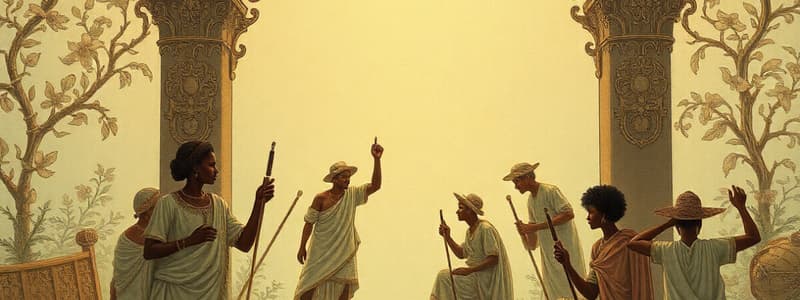Podcast
Questions and Answers
According to John Parker's recollection, what was one of the significant demands placed on the slaves?
According to John Parker's recollection, what was one of the significant demands placed on the slaves?
- To raise livestock for their masters
- To clear land for cotton cultivation (correct)
- To build roads for transportation
- To construct homes for their families
What effect did the slaveholders' power have on the slaves, according to the context?
What effect did the slaveholders' power have on the slaves, according to the context?
- Slaves had significant control over plantations
- Slaves faced little hardship during their labor
- Slaves frequently resisted their conditions
- Slaves were unable to mobilize collectively (correct)
What aspect of the slave society is highlighted as being significant in the content?
What aspect of the slave society is highlighted as being significant in the content?
- Its isolation from the rest of America
- Its cultural diversity and practices
- Its wealth and power despite a small population (correct)
- Its influence over northern states
What was the main challenge faced by slaves when adapting to new environments?
What was the main challenge faced by slaves when adapting to new environments?
Flashcards
Slaveholding Power
Slaveholding Power
A small percentage (7%) of white Southerners held a significant proportion (75%) of enslaved people, controlling crucial institutions like banks, and dominating the federal government.
Slaveholders' Achilles' Heel
Slaveholders' Achilles' Heel
Slaves were both the source of power and vulnerability for slaveholders as their resistance undermined their authority.
Slave Resistance
Slave Resistance
Various actions taken by enslaved people to undermine slavery, including flight, work stoppages, and acts of defiance.
Slave Flight
Slave Flight
Signup and view all the flashcards
Family Separations
Family Separations
Signup and view all the flashcards
Slave Bonds of Affection
Slave Bonds of Affection
Signup and view all the flashcards
Everyday Resistance
Everyday Resistance
Signup and view all the flashcards
Large-Scale Revolt
Large-Scale Revolt
Signup and view all the flashcards
German Coast Uprising
German Coast Uprising
Signup and view all the flashcards
Gabriel Prosser's Rebellion
Gabriel Prosser's Rebellion
Signup and view all the flashcards
Nat Turner's Rebellion
Nat Turner's Rebellion
Signup and view all the flashcards
"Slaves' Politics"
"Slaves' Politics"
Signup and view all the flashcards
Political Expression
Political Expression
Signup and view all the flashcards
Cotton Industry
Cotton Industry
Signup and view all the flashcards
7%
7%
Signup and view all the flashcards
75%
75%
Signup and view all the flashcards
Disproportionate Control
Disproportionate Control
Signup and view all the flashcards
Federal Government Dominance
Federal Government Dominance
Signup and view all the flashcards
Incentive
Incentive
Signup and view all the flashcards
Work Stoppages
Work Stoppages
Signup and view all the flashcards
Study Notes
Slaveholding Power
- By 1860, a small percentage of the white population (7%) owned a large percentage of the slaves (75%).
- Slaveholders dominated key institutions including banks, merchant houses, factories, railroads, and shipping concerns.
- Slaveholding power was derived from a disproportionate share of control over the federal government with the majority of presidents, supreme court justices, and other prominent figures coming from slave states.
Slaveholders' Achilles' Heel
- Slaves were the source of slaveholders' strength and their Achilles' Heel as slaves worked to undermine slaveholders' power and authority.
- Slaves did not fulfill planters' dreams as they were often forced to work hard and constantly to keep up with the demands of the booming cotton industry.
- Slaves did not work well because they had no incentive to do so.
Slave Resistance
- Flight was one of the most widespread means by which slaves sought to claim back their labor and freedom.
- The forced movement of slaves, including family separations, caused challenges to slaveholders.
- Slave owners used bonds of affection as leverage to maintain power, often using family members as bargaining chips.
- Tensions existed between slaves, but they continued to resist in various ways.
- The everyday actions of slaves, including work stoppages and displays of insolence, were constant challenges to slaveholders.
- A large-scale revolt like that in Haiti was unlikely due to the racial and demographic makeup of the American South.
- While large scale rebellions were rare, slaves resisted in ways that undermined the system of slavery including individual acts of defiance, work stoppages, and flight.
- The German Coast uprising, Gabriel Prosser's rebellion, and Nat Turner's Rebellion all marked significant attempts to challenge the system of slavery and exposed the vulnerabilities of the slaveholding society.
- Everyday resistance, small and large, created a "slaves' politics" which influenced the outcome of the civil war.
- Slaves' continuous efforts to claim their humanity was an act of political expression and resistance.
Studying That Suits You
Use AI to generate personalized quizzes and flashcards to suit your learning preferences.



